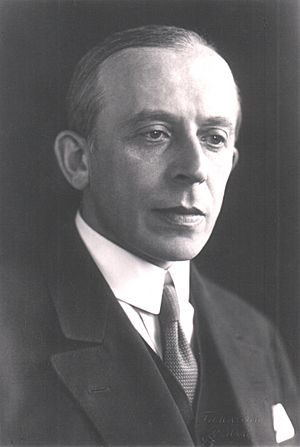Richard von Mises facts for kids
Quick facts for kids
Richard von Mises
|
|
|---|---|
 |
|
| Born | 19 April 1883 |
| Died | 14 July 1953 (aged 70) Boston, Massachusetts, US
|
| Education | Vienna University of Technology |
| Known for | von Mises distribution Von Mises transformation Von Mises statistic Bernstein–von Mises theorem Cramér–von Mises criterion von Mises yield criterion Von Mises–Fisher distribution Random sequence Sample space V-statistic |
| Spouse(s) | Hilda Geiringer |
| Relatives | Ludwig von Mises (brother) |
| Scientific career | |
| Fields | Solid mechanics, fluid mechanics, aerodynamics, aeronautics, statistics and probability theory |
| Institutions | Brno University of Technology University of Strasbourg TU Dresden Humboldt University of Berlin University of Istanbul Harvard University |
| Doctoral advisor | Georg Hamel |
| Doctoral students | Stefan Bergman Hermine Agavni Kalustyan |
Richard Edler von Mises (born April 19, 1883 – died July 14, 1953) was an important Austrian scientist and mathematician. He worked on many different areas of science. These included how things move (mechanics), how liquids and gases flow (fluid mechanics and aerodynamics), and how planes fly (aeronautics). He also studied statistics and probability theory, which deal with chance and data.
Richard von Mises was a professor at Harvard University. He once described his work as dealing with "practical analysis, integral and differential equations, mechanics, hydrodynamics and aerodynamics, constructive geometry, probability calculus, statistics and philosophy." He was also interested in philosophy, especially ideas about how we gain knowledge. He was a recognized expert on the poet Rainer Maria Rilke.
Contents
Early Life and Education
Richard von Mises was born in Lemberg, which was part of Austria-Hungary at the time. He came from a Jewish family. His older brother, Ludwig von Mises, later became a famous economist. Richard's father, Arthur Edler von Mises, was an expert for the Austrian State Railways.
Richard went to the Akademisches Gymnasium in Vienna. He was a very good student and graduated with honors in Latin and mathematics in 1901. After that, he studied mathematics, physics, and engineering at the Vienna University of Technology.
In 1905, while still a student, he published an article about the geometry of curves. This showed his early talent for mathematics.
Becoming a Professor
In 1908, Richard von Mises earned his doctorate from Vienna. His main project was about how to figure out the size of flywheels in engines. The next year, in 1909, when he was only 26, he became a professor of applied mathematics in Straßburg (now Strasbourg, France). At this time, Straßburg was part of the German Empire.
Work During World War I
Before World War I, Richard von Mises was already a pilot. He also taught university courses on how to design and fly aircraft. When the war started, he joined the Austro-Hungarian army. He worked as a test pilot and taught others how to fly.
In 1915, he helped build a powerful aircraft for the Austrian army. This plane was called the "Mises-Flugzeug." It was finished in 1916, but it was never used in actual combat.
Career After the War
After World War I, von Mises became a professor at the Dresden Technische Hochschule. He held a new position focused on how liquids and gases flow, especially around aircraft.
In 1919, he became the director and a full professor at the new Institute of Applied Mathematics at the University of Berlin. He also started a scientific journal called Zeitschrift für Angewandte Mathematik und Mechanik in 1921 and became its editor.
Moving to Turkey and the United States
When the National Socialist Party came to power in Germany in 1933, Richard von Mises felt unsafe because of his Jewish background. Even though he had served in World War I, he decided to leave Germany.
He moved to Turkey and became a professor at the University of Istanbul. He taught pure and applied mathematics there. In 1939, he moved again, this time to the United States. In 1944, he became the Gordon McKay Professor of Aerodynamics and Applied Mathematics at Harvard University.
In 1943, he married Hilda Geiringer. She was also a mathematician and had been his assistant. They moved together from Germany to Turkey and then to the U.S.
Important Contributions to Science
Richard von Mises made many important contributions to science and engineering.
Understanding Air and Flow
In the study of how air moves (aerodynamics), he made big steps in understanding how air flows very close to surfaces, like an airplane wing. This is called "boundary-layer flow." He also helped design better airfoils, which are the shapes of wings that help planes fly.
Strength of Materials
He developed an important idea called the distortion energy theory of stress. This theory helps engineers figure out how much force a material can handle before it breaks or changes shape permanently. It's one of the most important ideas used in designing strong materials. He also helped create the von Mises yield criterion, which is another way to predict when materials will start to deform.
Probability and Chance
In probability theory, which is the study of chance, Richard von Mises was the first person to talk about the famous "birthday problem." This problem asks how many people you need in a room for there to be a good chance that two of them share the same birthday. He also explored the idea that it's impossible to create a perfect gambling system that always wins.
The Gesellschaft für Angewandte Mathematik und Mechanik (Society of Applied Mathematics and Mechanics) gives out a special award called the Richard von Mises Prize to honor his work.
Images for kids
See also
 In Spanish: Richard von Mises para niños
In Spanish: Richard von Mises para niños
- Birthday problem
- Impossibility of a gambling system
- Bernstein–von Mises theorem
- Cramér–von Mises criterion
- von Mises distribution


